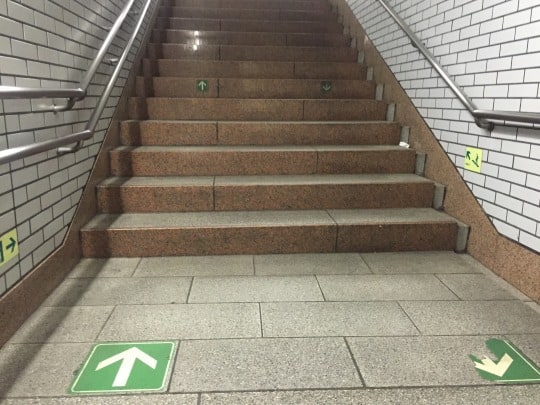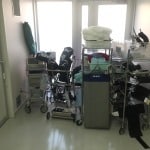This tweet and photo made me chuckle the other day…
If it's “your right” or “your left” as you're going up or down the stairs, collisions are going to happen if everybody followed these instructions:
https://twitter.com/nilrod/status/538084701509271552
In Japan, during our recent tour, I saw many extremely crowded subway and train stations. Their stairs were generally labeled with clear visuals showing which side should be used for going up or for going down. These rules were rarely violated.
Here's a picture showing these visuals when it was surprisingly empty in one station.

A simple visual like this is far easier to understand than a lot of words (and harder to misunderstand). The same principle can be effective in standardized work documents, relying on pictures (or even videos) when that's easier to understand or harder to misunderstand than a bunch of words would be.
We often see the same thing with 5S in the workplace… instead of hanging signs that tell people where to store things, we can use tape outlines or signs with photos making it far easier to understand what goes where.
There's often a misperception about 5S and visual management. People seem to think this “comes naturally” to Japanese people or to Japanese organizations. I learned in 2012 that “pulling the andon cord” or speaking up to point out a problem doesn't come naturally to people in the Japanese culture. The Toyota Production System or a “Lean culture” is something that organizations have to work at – that's true for Toyota and it's true for Japanese hospitals.
From the four different Japanese hospitals I've visited in my two trips, their workspaces weren't inherently any more organized or free of clutter than an American hospital. I've seen pockets of 5S activities but it's certainly not the default condition. There are many rooms and cabinets that are just as messy looking as we'd see at hospitals anywhere.
Some photos from various Japanese hospitals (click for larger views):
I mean no disrespect by sharing these photos. That's the reality of their gemba. There are opportunities for improvement. The hospitals in Japan do many things well, namely their consistent and widespread focus on structured PDSA/PDCA improvement. But, they don't all have rigorous daily Kaizen approaches and they aren't magically organized and 5S-ed.
 Japanese hospitals, as much as we can generalized, will point out how they aren't factories. One hospital we visited has a specific “Lean” initiative and they travel to Seattle to learn from Virginia Mason Medical Center, a hospital that sends people to Japan to learn from factories. I'll share more about those Lean efforts in future posts in this Japan Tour series. Other hospitals have strong quality improvement cultures, based on TQM, that also incorporate some Lean methods.
Japanese hospitals, as much as we can generalized, will point out how they aren't factories. One hospital we visited has a specific “Lean” initiative and they travel to Seattle to learn from Virginia Mason Medical Center, a hospital that sends people to Japan to learn from factories. I'll share more about those Lean efforts in future posts in this Japan Tour series. Other hospitals have strong quality improvement cultures, based on TQM, that also incorporate some Lean methods.
But, if people in your organization make excuses like, “This would be easy in Japan,” it might be worth reconsidering that. Maybe it's difficult EVERYWHERE to create a great Lean culture?
What do you think? Please scroll down (or click) to post a comment. Or please share the post with your thoughts on LinkedIn – and follow me or connect with me there.
Did you like this post? Make sure you don't miss a post or podcast — Subscribe to get notified about posts via email daily or weekly.
Check out my latest book, The Mistakes That Make Us: Cultivating a Culture of Learning and Innovation:














[…] management practices. Mark Graban has blogged about his experiences going to gemba in Japanese hospitals. […]
[…] Words vs. Simple Visuals; A Secret About Japanese Hospitals […]
[…] Graban has made a similar observation in his visits to Japan that it is rare to see health systems applying Lean […]